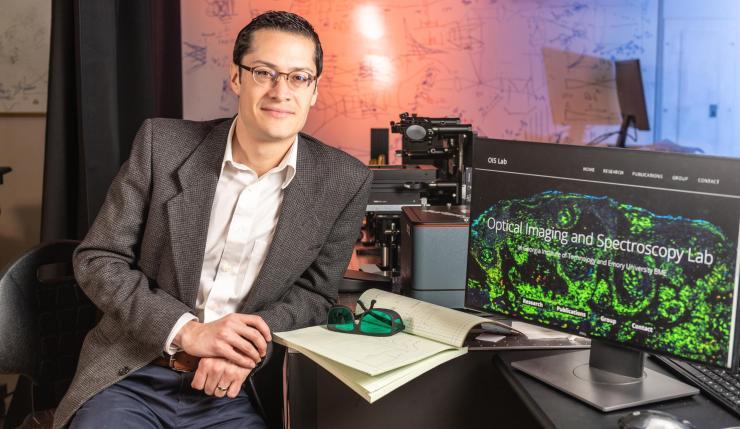New Company Formed to Advance Novel Blood Cell Analysis Technology
Oct 27, 2022 — Atlanta, GA

Coulter BME researcher Francisco Robles has launched a new company based on technology developed in his lab.
Before patients can begin a regimen of some critical treatments – like a life-saving round of chemotherapy – they must undergo a hematological analysis.
This prerequisite blood test involves a complex roadmap of expensive equipment, not to mention the trained personnel to calibrate, maintain, and use it, plus multiple reagents, and finally, time to test the sample in a specialized lab. The process can take hours or anxious days, delaying the administration of a treatment. That’s how it usually works.
But a new company spun out of innovative research in the Wallace H. Coulter Department of Biomedical Engineering at Georgia Tech and Emory University aims to break with that tradition and eliminate those delays. Cellia Science, Inc., is developing point-of-care hematology analyzers based on the innovative ultraviolet (UV) microscopy system developed in the lab of Associate Professor Francisco Robles, who serves as the company’s chief science officer.
Built with funding from VIC Technology Venture Development, Cellia’s first device will specifically be designed to help chemotherapy patients at risk of neutrophenia (when a patient has too few neutrophils, an infection-fighting white blood cell) or thrombocytopenia (a low blood platelet count).
“These are life-threatening conditions that can alter a treatment plan and need to be addressed immediately. Because if a patient isn’t healthy enough to begin their actual cancer treatment, that will pause the care plan, which can cause negative downstream effects,” said Robles, whose lab had been developing advanced UV microscopy technology for years but hadn’t really focused on a precise application, until now.
The emphasis on white blood cell differential testing and platelet counts grew out of Robles’ collaboration with Professor Wilbur Lam, a faculty member in the BME department and the Emory School of Medicine’s Department of Pediatrics, and a physician in the Aflac Cancer and Blood Disorders Center of Children’s Healthcare of Atlanta.
“We looked at many applications for our system, but after working with Dr. Lam and researching the needs of clinicians about where a device would really have the most immediate impact, we started moving directly toward this space,” Robles said.
When cancer patients’ neutrophil counts are low and they develop a fever, they’re at risk of developing a life-threatening infection and time is not on their side.
“The capability to easily monitor neutropenia in cancer patients at the point-of-care can be game-changing,” said Lam, whose own lab has developed affordable point-of-care technology for blood disorders, often employing a patient’s own smartphone.
The Robles team introduced the technology that would spawn Cellia two years ago in a study that describes a novel, label-free optical assay that can sidestep the limitations in the current standard of care, providing analysis of tens of thousands of live cells in minutes, instead of waiting for days, without any sample preparation.
Essentially, they had merged two different tests – a complete blood count (CBC) and microscopic analysis – into one. The plan is to combine them into something small, compact, portable, affordable, and easy to use, at first by caregivers in the clinic or even at your local drugstore, but eventually by patients themselves at home.
“The UV microscopy system developed in Roble’s lab has the potential to revolutionize how blood cells are analyzed and imaged and can lead to groundbreaking diagnostic technologies that will directly impact patients’ lives,” Lam said. “This technology has the potential to not only improve the quality of life of cancer patients but decrease mortality as well.”
Initially, the device would be built and marketed for a range of clinical settings, including the corner drugstore.
“It is definitely within reach that your lab or pharmacy tech will be able to do the finger prick and load the device with a blood droplet and administer the test,” Robles said. “We only use one microliter of blood and from that we’re able to make a diagnosis very well. It’s fast, reliable, and quantitative. Our device has the potential to simplify and improve hematological analysis right there in the clinic and eventually, at home, where parents will be able to monitor their own blood counts.”
The technology’s pathway toward commercialization went through the Phase Zero Program in the Global Center for Medical Innovation, or GCMI, which is a Georgia Tech affiliate. This was the key to linking up with VIC Technology Venture Development – GCMI Director of Scientific Affairs, Evan Goldberg, is also a senior VIC fellow.
VIC has licensed the technology exclusively through Georgia Tech’s Office of Technology Licensing. The venture firm has installed Kelly Mabry, VIC’s executive-in-residence and a former VIC fellow, as Cellia’s chief executive officer. Lam is onboard serving as chief medical officer.
“This is my first company,” Robles said. “The support from GCMI has been critical, and Wilbur has started a few companies. So, I’ve been surrounded by real experts when it comes to the commercialization aspects of this journey. The hope is that, before too long, this technology will be available to help patients.”
Writer: Jerry Grillo




